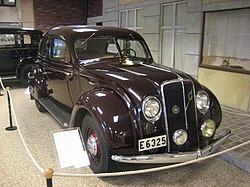Volvo PV36
| Volvo | |
|---|---|
|
Volvo PV 36 in the factory museum
|
|
| PV 36 | |
| Sales designation: | PV 36 |
| Production period: | 1935-1938 |
| Class : | upper middle class |
| Body versions : | limousine |
| Engines: |
Petrol engines : 3.6 liters (64 kW) |
| Length: | 5000 mm |
| Width: | |
| Height: | |
| Wheelbase : | 2950 mm |
| Empty weight : | 1660 kg |
| successor | Volvo PV 51-57 |
The Volvo PV 36 is the Swedish vehicle manufacturer Volvo from 1935 to 1938 produced mixed vehicles . After Volvo began exporting its vehicles to Brazil in 1933 , the car was soon given the nickname “Carioca”.
At first glance, the exterior of the car developed by Ivan Örnberg, a Hupmobile engineer , is very similar to the Chrysler Airflow . This is because Volvo copied many design elements from vehicles from North American manufacturers in the 1930s and 1940s and incorporated them into its vehicles.
Inside the car, a 3.6 liter six-cylinder engine has an output of around 80 hp, and the car is the first to be produced by Volvo with an independent front wheel suspension . The vehicle's wheelbase is 2.90 meters.
Since the car with a purchase price of about 8500 Swedish kronor was hardly affordable and quite expensive for potential buyers, less than 500 copies of the vehicle were produced. The last car was only sold shortly before the end of production in autumn 1938 and was used by the Swedish embassy in Tehran .
Individual evidence
Web links
- Volvo Cars Report
- Volvo Museum
- Storvolvoklubben (Swedish)

